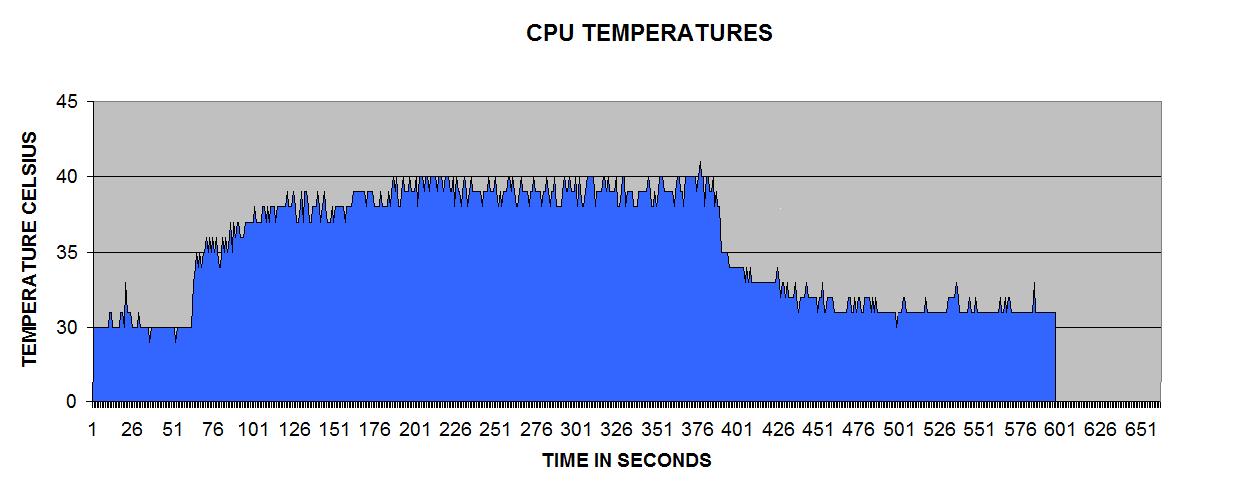Supposed to work with any motherboard. Monitors and logs CPU temperature of each core and physical CPU. No installation required.
http://www.alcpu.com/CoreTemp/
+ Reply to Thread
Results 1 to 9 of 9
-
-
Doesn't work with Xeon based processors. It gives me a
Pity, because I've been looking for a temperature monitor for my laptop for quite a while now.Code:This is not an Intel "Core" Architecture based processor. This program will not continue.
ICBM target coordinates:
26° 14' 10.16"N -- 80° 16' 0.91"W -
This might work (never tried it, though)
http://www.softpedia.com/get/System/System-Info/MobileMeter.shtml -
Thanks Soopafresh!
A nice little free utility that's an alternative to TAT...
Nice to have in the toolbox for those of us than plan to have an intel upgrade plan...
TAT is cool but I think between CPUID and this I can wean my addiction between these 2 programs.
EDIT: Sorry, just a bit faced but still cool nonetheless! -
I have used an older version of this program. They recently updated it for the AMD Phenom CPUs. The most useful feature for me is the temperature logging. With that you can check the performance of your CPU cooler when you run a CPU intensive program like encoding and see how your cooler responds to the CPU load.
If you open the log in a program like Excel, you can covert the data to a graph:

This was a Divx encode with all four cores at about 50%. I run Cool & Quiet, so the CPU multiplier ramps the CPU up to about 2500Mhz, that's the reason for the fairly sharp temp rise. As the encode finishes, the CPU returns to about 1200Mhz and the temperature drops fairly quickly. That shows good recovery and also shows that the case temps are fairly good or it would take longer to drop. The spikes in the chart are misread temperatures (noise) and changing the log interval to a longer number, maybe 3 seconds or more would smooth that out. I could have smoothed it in Excel, but I forgot that function. It's OK for a quick view, though.
-
A Xeon laptop?Originally Posted by SLK001Recommends: Kiva.org - Loans that change lives.
http://www.kiva.org/about -
No, I tested this on my work machine. My laptop is a Toshiba. The only program that I have found that could report the temp on my Toshiba is a shareware program named hmonitor. It was fairly expensive for what it did.Originally Posted by edDV
I am planning on testing this on my laptop (two trains of thought got combined in the answer!).ICBM target coordinates:
26° 14' 10.16"N -- 80° 16' 0.91"W -
Doesnt this show the wrong temp (by 15deg) on newer xx50 processors? I think I used to use this but it was consistently inconsistent. I use speedfan and cpuz, and I dont really trust speedfan all the time, core0 and core1 are the only readings I think are correct...
 core0+1 30c core 44c
Corned beef is now made to a higher standard than at any time in history.
core0+1 30c core 44c
Corned beef is now made to a higher standard than at any time in history.
The electronic components of the power part adopted a lot of Rubycons. -
You are best going to the motherboard manufacturers site for a temperature monitor. It seems like just about every motherboard uses a different method and offset to properly measure CPU and other temperatures. I've found several discrepancies with some aftermarket temperature reading programs.
But if none are available from the manufacturer, go ahead and try one of the aftermarket temp readers. You should be able to double check the temps in BIOS with the hardware monitors most motherboards have there. Be aware those temps may be on the high side. When the OS and drivers are loaded, many MB drivers can adjust FSB CPU frequencies, multipliers and even CPU voltages. That can lower the CPU temps.
Or better, IMO, try a infrared temperature monitor like this, less then $20US and you can read the temps directly from the surface of the heatsink or device: http://www.directron.com/mt100.html There are many other similar devices out there. They also work for many other non-electronic devices.
Or quick and easy, use the tip of your finger. A temp of 50C will not allow you to hold your finger there very long and is warmer than you want most devices to run. A 30C temp will be mildly warm and is a decent temp with no problems. 40C is fairly warm. OK for most any device, but cooler is better. 60C will be painful to you and your CPU.
Similar Threads
-
CPU Temp Erratic and High in BIOS?
By bevills1 in forum ComputerReplies: 3Last Post: 7th Jul 2011, 12:09 -
CPU temp "alert"
By Edgarke16 in forum ComputerReplies: 2Last Post: 20th Feb 2011, 18:44 -
CPU Temp.
By HotDamn! in forum ComputerReplies: 33Last Post: 8th Mar 2010, 14:21 -
Standalone app to write SSA script?
By David_UK in forum SubtitleReplies: 3Last Post: 29th Mar 2009, 11:32 -
CPU Temp
By Willy5157 in forum ComputerReplies: 4Last Post: 9th Feb 2008, 21:22




 Quote
Quote